Get a Head Start on Copywriting_ The 10 Best Copywriting Books to Read (Spring 2023)
Copywriting isn’t something that’s taught in schools the way other areas of marketing are, and it can be hard to know where to start when it comes to learning everything there is to know about copywriting.
And to make matters worse, with so many copywriting books on the internet, it becomes a real pain in the neck to know which ones will help you in your copywriting career and the one’s with less or no significance.
But, here comes the good news, we took the pain to do a research on the 10 best copywriting books you can read to master the art of copywriting.
We’ll walk you through a short review of what you can expect from each one so you can decide which one will work best for your own needs and interests.
| Name | Nomination | Overall rating |
|
Jim Edwards has extensive experience with copywriting and has proven time and time again that he knows his stuff in Copywriting secrets. |
Editor’s Choice | 9.9 |
|
2. The Adweek Copywriting Handbook It is a comprehensive and thorough manual that will help you take full advantage of Python’s capabilities |
Best for Advertising Copywriting |
9.8 |
|
3. How to Launch a Freelance Copywriting Business Do you want to start a freelance writing career? This practical copywriting book is excellent for journalists, copywriters, and content writers who want to apply their existing writing expertise to business copywriting. |
Best for Freelance Writers | 9.7 |
|
Copywriting Made Simple is a straightforward approach to learning the fundamentals of successful copywriting. This is a good small book with many good tips for anyone who wishes to write persuasive copy. |
Best on Persuasion Copywriting |
9.6 |
|
5. How To Write Emails That Sell If you want a large book full of mistakes that take days to read, this book is not for you. However, this book is for you if you want quick, brief, and good knowledge on monetizing your email campaigns correctly. |
Best for Email Copywriting | 9.5 |
|
The thought, knowledge, and research that goes into producing a successful sales pitch that delivers results is the focus of this book. This is the method and structure that David Garfinkel refers to as “Breakthrough Copywriting.” |
Best Practical Approach | 9.4 |
|
7. A Self-Help Guide for Copywriters This concise book offers real-world examples of killer headlines and provides a step-by-step strategy to develop fresh ideas. |
Best for Beginners & Professionals | 9.3 |
|
8. The Halbert Copywriting Method Part III This book by Bond Halbert explains how sales copy is intended to capture the readers’ hearts and provoke some emotional response that leads to sales. |
Most In-Depth Approach | 9.1 |
|
9. The Ultimate Copywriting Guide for Beginners to Advanced This book is aimed at newbies, entrepreneurs, and business owners who want to improve their results using effective copywriting methods and best practices. |
Best Short Course | 9.0 |
|
A typical book that covers a wide variety of copywriting methods and approaches that are basic pillars of the copywriting profession is this handbook by Robert W. Bly. |
Best with Additional Information |
8.9 |
Detailed Product Reviews
Features:
- Author name: Jim Edwards
- Level of proficiency: both beginners & professionals
- Publisher: Author Academy Elite
- Edition: Illustrated edition (December 10, 2019)
- No of Pages: 328
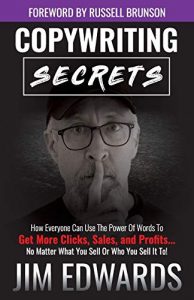
Copywriting Secrets is an excellent book for those looking for a deep dive into copywriting. Jim Edwards has extensive experience with copywriting and has proven time and time again that he knows his stuff. This book lets you in on how to craft the best sales letter, discusses how to quality content that converts, and provides various strategies for creating copy that entices customers or readers to take action. It’s one book that will teach you how to be more persuasive in your writing.
Jim explains in his book that copywriting is the art of selling. You get to understand that for you to make sales, you need to let your prospect know why they should give a listening ear to what you’re selling.
The book highlights that hopes, dreams, fears and desires are excellent for persuasion because when people become inquisitive, they don’t buy. This book will teach you everything from what copywriting is, how it can be used, why it’s important, the dos and don’ts of good copy, and so much more.
What we liked
- A handy book if you do online advertising
- It explains how copywriting is not a one size fit all approach
- You’ll learn the concept of a persuasive copy on target audience
- Both entertaining and thought provoking in equal measure
- The book is simple to read even for non-native speakers
What could be better
- The main emphasis on some pages of this book is on headlines and headings
- Constant mention of Funnel Scripts in which beginners may find confusing
Features:
- Author name: Joseph Sugarman
- Level of proficiency: beginners & professionals
- Publisher: Wiley
- Edition: 1st edition (December 11, 2006)
- No of Pages: 368
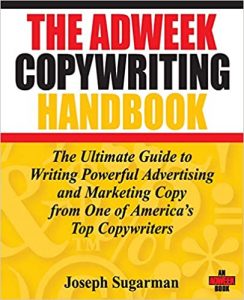
Joseph Sugarman is regarded as one of America’s top copywriters and a legend in the advertising world. He specialized in infomercials and direct marketing, and he assisted in the distribution of items such as calculators, cordless phones and digital watches to consumers. Sugarmann was also the first to accept credit card payments over the phone, which transformed direct marketing.
Although his book is based on research from the 1970s, it contains information about selling triggers and writing techniques that are still relevant today. The Adweek Copywriting Handbook reveals timeless and precious copywriting concepts that even the most inexperienced copywriter may utilize to persuade his prospects to be willing to let go of their hard-earned money.
What we liked:
- An amazing handbook tailored for display advertisement copy
- Sugarman explained with personal stories and examples of sales letters for easier understanding
- The book is written in a smooth conversational tone
- Great information to create great copywriting
What could be better:
- Image quality
Features:
- Author name: Jules Horne
- Level of proficiency: both for beginners and professionals
- Publisher: Texthouse
- Edition: (February 8, 2018)
- No of Pages: 198
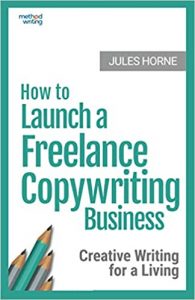
Like most writers, you have great writing skills but aren’t so great at business. Perhaps you’re unclear on how to get your foot in the door and secure your first commercial writing employment and how to pitch your business to people confidently. This book sheds light on business culture.
It teaches how to create a freelance copywriting business from the ground up, acquire clients, build a job pipeline, manage time and money, and survive and flourish on the freelancing frontline.
The book contains useful and important information for individuals who want to start their own copywriting business from the first page. Jules Horne has an uncanny ability to keep the reader focused on what is vital and what they should avoid. This book, however, takes a very pragmatic approach.
What we liked:
- Teaches you how to launch a freelance copywriting business
- A good reference for any copywriter or newbie
- Very down-to-earth, realistic and actionable.
- The book is easy to read and well-written.
What could be better:
- More like a bunch of tips
Features:
- Author name: Tom Albrighton
- Level of proficiency: both beginners and professionals
- Publisher: ABC Business Communications Ltd
- Edition: (June 6, 2020)
- No of Pages: 305
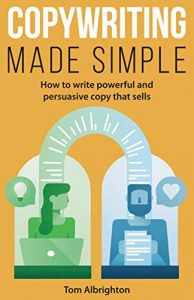
Tom Albrighton’s Copywriting Made Simple outlines the difficulties and daily briefs that a copywriter must deal with regularly. It is not intended for someone new to the field of writing but rather for a professional hoping for a new career. The book comes in three sections: Plan Your Copy, Write Your Copy, and Improve Your Copy.
The first stage of copy planning was fairly basic marketing actions that would generally be known before confronting a book like this. This part, however, was necessary for a complete discussion of the topic. Therefore, before writing the brief, the material was about knowing your product, its benefits, and your reader.
The second part of this book begins with material I was very interested in, such as how to write my text and what I should consider. While the knowledge may not be entirely novel, we must acquire information that supports and structures our work.
What we liked:
- The book explains how to plan, write and improve your copy
- It’s tailored for those in the advertising field
- Lots of practical advice and handy tips
- Offers a substantial reference list
What could be better:
- Not best suited for professionals who are experts already in the field
Features:
- Level of proficiency: beginners & professionals
- Publisher: Catapult Press
- Edition: (October 5, 2021)
- No of Pages: 72 pages
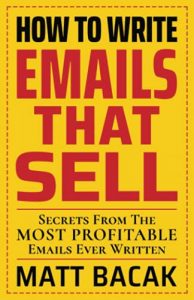
This book is perfect for anyone who wants to improve their email copy and make more sales. With step-by-step instructions, it teaches readers how to write compelling messages that will engage readers and increase their chances of getting an instant response.
Mark explains that you can send four types of emails with this book: transactional, informative, persuasive, and relationship-building.
Transactional emails usually include order confirmations or delivery updates. Informative emails inform customers about new products or changes; persuasive emails have subject lines like Opportunity Alert, and relationship-building emails show appreciation for loyalty by offering insider information.The book is a useful guide for beginners who want to write a better sales letter.
What we liked:
- It comes with practical examples you can apply
- Good basic intro for affiliate marketers
- The book is concise and to the points
- Ideal for beginners and experts in email copywriting
What could be better:
- Place its core focus on sales emails
Features:
- Author name: David Garfinkel
- Level of proficiency: both for beginners and professionals
- Publisher: CreateSpace Independent Publishing Platform
- Edition: (July 7, 2017)
- No of Pages: 154 pages
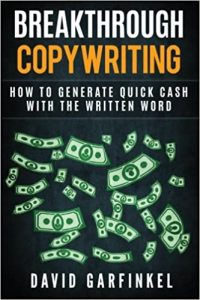
I read a lot of copywriting books since I find the subject intriguing. Many are nicely written, yet they frequently discuss well-known approaches. There are nice books on copywriting, but none are quite remarkable. This book is unique.
David Garfinkel is touted as the world’s finest copywriting coach, and you’ll see why as you read this. The book is based on content from the author’s $5,000 course.
He discusses essential new copywriting structures. The chapter on emotional triggers alone is definitely worth the price. This is a subject that many copywriters usually struggle with. In addition, the book has sections on topics like headlines, bullets, offers, and the usage of storytelling.
What we liked:
- The book explains the copywriting structure
- It is practical with the use of stories
- This book is a golden toolbox for newbies
- It’s an easy read
What could be better:
- Few mistakes in the editing
Features:
- Author name: Dan Nelken
- Level of proficiency: beginners & professionals
- Publisher: Dan Nelken
- Edition: (November 23, 2021)
- No of Pages: 176 pages
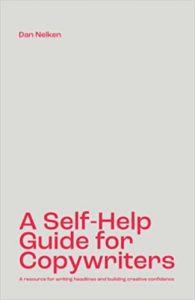
This guide caught me off guard. I expected a ‘mere’ copywriting book with samples of excellent ad copy to help me improve my craft.
While there are lots of real-life ad copy examples to get your creative juices flowing, this is the only book I’ve seen that admits how difficult it is to develop appealing copy consistently.
We don’t understand the process, which creates anxiety for the busy professional who has to develop ideas on the go. However, Dan Nelken, the author, graciously shares various repeatable strategies to inspire ideas. As a result, this guide is indispensable.
What we liked:
- The book is simple, practical, and essential
- It teaches how to write powerful headlines
- It comes in handy for both newbies and seasoned pros alike
- Packed with useful and time-saving tips and tricks for advertising
What could be better:
- The print quality could be better
Features:
Author name: Bond Halbert
- Level of proficiency: beginners & professionals
- Publisher: CreateSpace Independent Publishing Platform
- Edition: (June 5, 2016)
- No of Pages: 106 pages
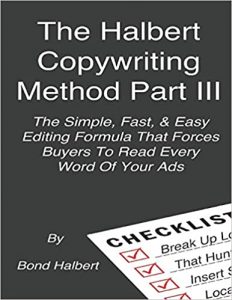
Bond Halbert is the son of Gary Halbert, who is often regarded as the best copywriter. He not only began studying from his father as a youngster, but he is also a great copywriter in his career.
According to the author, time spent on a copywriting task should be divided as follows: research, crafting the hook, headline, bullets, offer, and everything else in the copy, and editing the content.
This book covers the polishing process, making it essential reading. A lot of this is basic knowledge – make it easy to read, use short words, phrases, and paragraphs, and allow readers to receive a summary of the key idea.
What we liked:
- The book teaches how to polish a sales copy
- Explains how to edit for clarity
- It’s a great reference for aspiring marketers and copywriters
- place a good focus on direct response sales copy
- Suited for both beginners and experts
What could be better:
- Not the best image quality
Features:
- Author name: Neil Hoechlin
- Level of proficiency: beginners & professionals
- Publisher: CreateSpace Independent Publishing Platform
- Edition: (May 11, 2018)
- No of Pages: 52 pages
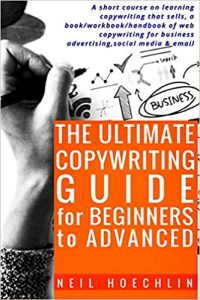
This book is great for beginners who want to learn the basics of copywriting and advanced copywriters looking for new tips and tricks. It has a lot of useful examples, so you can see how copy should be used in different scenarios, making it easier to understand than many other books on the subject.
This book is tailored for newbies, entrepreneurs, and business owners eager to improve their results through effective copywriting methods and best practices. Another great thing about this book is that you don’t need much writing experience to use it. However, those who want more advanced content may find that some of the ideas are too basic for them.
The Ultimate Copywriting Guide for Beginners to Advanced is also not a dry read, with sections including jokes and funny anecdotes thrown in here and there, making it an enjoyable read.
What we liked:
- You get to master the 4Us formula
- Throws useful insights on blog posts and website copywriting
- The book explains how to write a powerful CTA
- It provides actionable steps and examples
What could be better:
- The book editing could be better
Features:
- Author name: Robert W. Bly
- Level of proficiency: beginners & professionals
- Publisher: St. Martin’s Griffin
- Edition: Updated edition (April 7, 2020)
- No of Pages: 496 pages
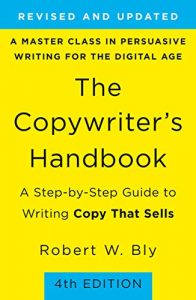
If you’re new to copywriting and want to learn more about sales strategies, this is the book for you. It has also been updated to remain relevant in the digital era.
In the book, you learn that: Writing to sell is not the same as writing to communicate. Instead, writing to sell is a skill that can be learned. The most crucial component of your copy is the headline. You have spent eighty cents of your dollar on writing your headline. If you don’t sell something in your headline, you’ve squandered 80% of your client’s money.
Write about benefits rather than features. Let the customer know how the product will help them and not the features of the products. Writing to sell directly connects to the self-interest of the reader. Indeed, the psychological components of this work are fascinating.
What we liked:
- You get to understand the BDF formula
- It teaches you the concept of a unique selling proposition
- The book helps you master the motivating sequence
- Places emphasis on how to write headlines and subject lines
- It contains practical examples for easier understanding
What could be better:
- Could be a bit overwhelming for beginners
Key Factors You Should Consider When Looking for the Best Copywriting Books
Whether you’re a freelance or in-house copywriter, choosing your next book is no easy task. Knowing which book to buy can be overwhelming, with so many books promising effective strategies for success.
This section will look at some factors you should keep in mind when choosing a copywriting book. The purpose? To help make your decision easier!
What is Copywriting?
Content is king, and that goes for copywriting. It’s used in marketing, advertising and sales. For example, a copywriter curates content, such as ads, emails and sales letters, to persuade people to buy a certain product or service.
The best copywriters are experts at analyzing their audience and tailoring their message accordingly. As a result, they can create persuasive copy that is both effective and engaging. Because of this, they’re often well-paid professionals.
However, not all jobs require someone with extensive training in this field. So if you want a career change or want to brush up on your skills so you can take on freelance work, it pays to know which books will give you the most bang for your buck.
What Does a Copywriter Do?

Copywriters are professionals who write text for advertisements and other promotional materials. One thing they do is help their clients sell more products or services. They do this by presenting ideas persuasively and through language that will resonate with the target audience.
In order to write a successful copy, you must be skilled at communicating. It would help if you also thoroughly understood your client’s product, industry, and target market.
How to Start Copywriting?
The first step to copywriting is knowing your audience. If you’re not sure who you’re writing for, it’s going to be hard to know what the audience wants and even harder to convince them that your product or service can solve the problem. Plus, if you don’t know what your target audience wants, how will you know when you’ve reached it?
Consider where your ideal customers are located and what age range they fall into. Next, figure out what products and services they might need. Do they have a specific problem you can offer help solving? Finally, what would happen if they didn’t get the product or service?
Does this mean they’ll have to find an alternative solution, take time off work to deal with the issue themselves, hire someone else to do it for them, or buy a competitor’s brand instead of yours? These are all questions worth considering before deciding on a course of action.
For instance, if I’m thinking about marketing my pet grooming business in New York City, then I should know that there are lots of people living here who own pets but also a lot of people who live here without pets (it’s illegal to own a pet as a renter).
Additionally, many residents are either retired or commute between the city and other places during weekdays, so they may not be home during the day. Those who cannot care for their pets alone may be interested in leaving town for longer and hiring a professional to look after their animal companion while they’re gone.
Types of Copywriting
Copywriting is a form of marketing that seizes words to persuade or convince readers. There are different types of copywriting, and these include the likes of email marketing, sales pages, and website content.
Email marketing may be more beneficial to use templates and not customize each one. For sales pages, it would be best if the copywriter was an expert in that industry so they could speak confidently about their product or service.
1. Marketing
The type of copywriting is used for marketing products and services to prospects, typically through mass media such as television or radio. The objective or goal is to create some kind of interest in the product or service, entice consumers into purchasing it, or inform them why they should buy from this company instead of others.
Copywriters usually specialize in a particular field but can also write general-purpose advertising text.
2. Advertising
This is a type of copywriting that focuses on persuading customers either to purchase a product or service. It may include information about what the product does, testimonials from satisfied customers, and comparisons with competitors’ products.
Advertising copywriting is more about convincing the customer, whereas marketing copywriting needs to create interest to sell the product.
3. SEO

Search engine optimization (SEO) copywriting involves optimizing the writing style and using specific keywords to help place your business higher up on search engine rankings when potential clients search for those keywords.
However, you don’t want to push it because too much keyword stuffing will lead Google to penalize your site.
4. Persuading
An artful persuasion technique employed in direct mail marketing and other advertisements where the objective is to compel readers to take action, such as buying a product.
Level of Proficiency
Your level of proficiency in a niche like copywriting is one factor you’ll have to consider when looking for the best copywriting books to hone your writing skills.
Beginners: If this is your first time dealing with any type of marketing, it would be in your best interest to get an overview book that provides the fundamentals.
Books that share light on what goes into a great copy and an introduction to the different types of copywriting. Once you learn the basics, you can delve into more advanced topics on copywriting.
Intermediate: You should have a decent grasp of copywriting before you delve into more advanced techniques and strategies. This is true if you are looking into integrating your copy with sales letters, infomercials or advertisements.
Then you don’t need a beginners handout. Instead, you want something that takes a step further.
More Experienced: If you’re already familiar with various aspects of copy, there are many resources that can help improve your copywriting skills and make them more effective. Some people might find these options so useful that they may never use another copywriting book again.
Nevertheless, knowing where you stand in terms of knowledge is important because the last thing anybody wants is to spend their money on something that will bore or confuse you instead of teaching you new tricks.
Frequently Asked Questions
Is copywriting relevant in 2022?
Yes, it is still very much relevant and necessary. One of the main ways businesses differentiate themselves from their competitors is through marketing campaigns via emails, sales letters and the like. Consumers are more conscious, and it’s more important than ever that they feel connected with a business’s values, mission, and brand story. Suppose a business can’t connect with consumers. In that case, they’ll look at a company as another faceless entity competing for attention, often leading them to either buy elsewhere or stop buying altogether.
How can I understand what type of copywriting is perfect for my business?
There’s a system for choosing an appropriate type of copywriting that’s right for your business. It revolves around discovering who your customers are and what they’re struggling with. Once you know more about them, you can create copywriting campaigns aimed at their wants and needs rather than at random.
Our Verdict
Great content is a crucial part of any business in our small world today.
Whether you’re just starting as a startup or your business has been around for some time, it’s something you have to invest in at a certain level if you want to take a step further.
We understand that learning is the first step to anything great, even a business.
That’s why we took the time to curate this detailed review of the best copywriting books in the hopes that this should set you on the right path to learning the skilled art of copywriting.
But, if you still find yourself between the ropes in picking the book that best suits your business or needs. Our top three picks are “Copywriting Secret,” “Breakthrough Copywriting,” and “The Copywriter’s Handbook.”
Nonetheless, any of the books you pick on the list are sure not to disappoint.
